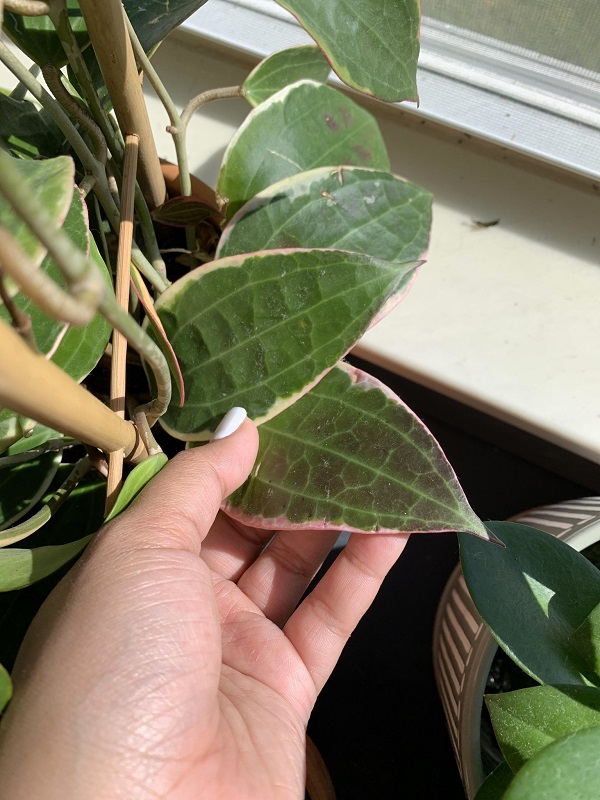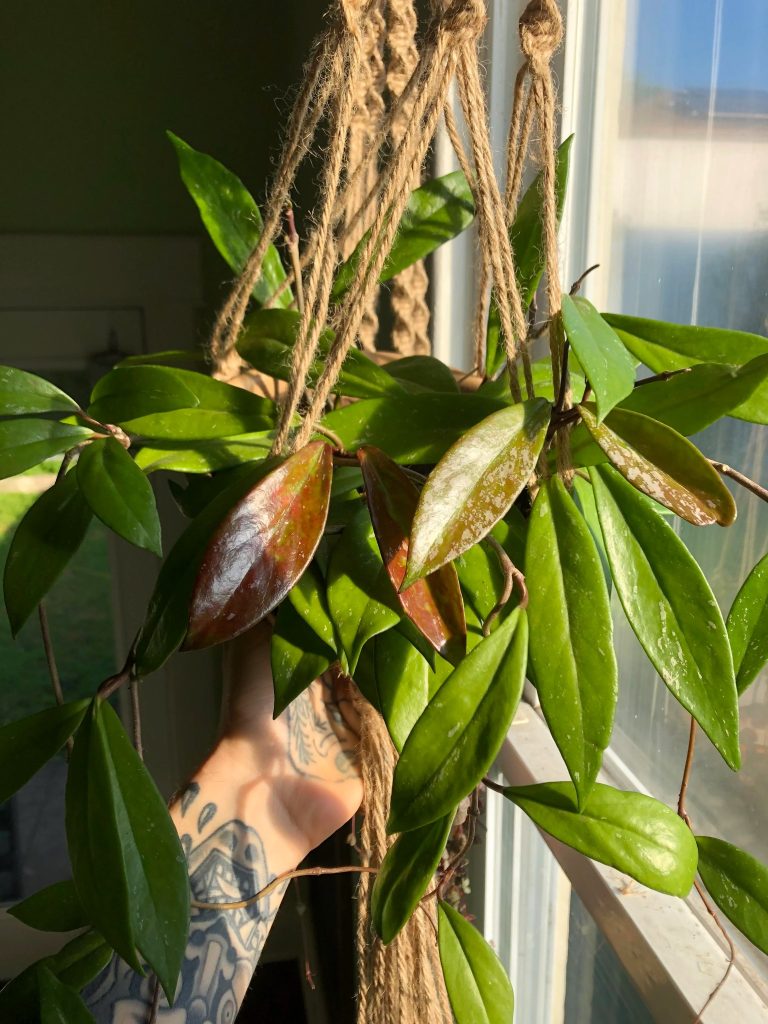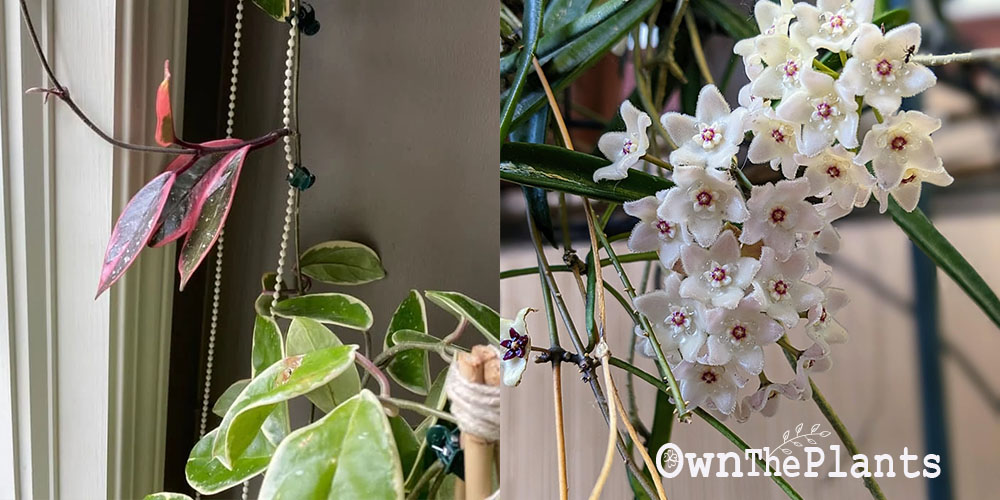Hoyas are among the most beautiful vining flowers there are, arguably, around the world. The wide range of colors and shapes available make them a good choice for plant collectors.
But in order to catch a glimpse of their magnificent blooms, one must know their specific requirements, especially light.
The quality and quantity of light is very important for a plant to grow and flower. It is because many genes responsible for growth and flowering are only activated with sufficient light.
If the light requirement is not met, do not expect your plant to grow optimally and bloom.
Lucky for you! We will help you understand your Hoya more so that you can give it the best care it deserves.
In this article, you will learn about the optimum light requirements for your Hoya – when it is lacking, when it is sufficient, and when it is too much for your plant to handle.
Getting To Know Hoyas

Hoya plants, also commonly called Wax Flowers or Wax Plants, belong to the dogbane family, Apocynaceae.
They are close relatives of Frangipanis and Nerium flowers. As of the present, there are approximately 500 accepted species of Hoya.
These beautiful vines are tropical. They are mostly native to Asian countries such as Philippines, Thailand, India, Malaysia, Polynesia, and Indonesia, among others. Hence, they best thrive in tropical-like environments.
Do Hoya Plants Like The Sun?
Since Hoya plants hail from the tropics, you would be sure that they thrive in tropical-like environmental conditions. A tropical environment includes a moist, humid air, warm temperature, and a lot of sunlight.
As we all know, plants require light in order to survive, and in the case of Hoya plants, a bright sunlight is the best, as long as its indirect.
Although some Hoyas survive in low-light conditions, they generally like the sun on their leaves.
What Is The Light Requirement For Hoyas?

Hoya plants can be grown indoors and outdoors, as long as the basic requirements are met.
As for the light, a bright indirect type is best for your Hoya to thrive. Extremely low conditions will make your Hoya grow slowly, while direct light exposure burns them.
In order for you to efficiently give your plant the best light for them, consider following these steps:
- When grown indoors, consider putting your plant close to a window where bright indirect sunlight is always available.
- You can use sheer curtains to filter excess light during specific times of the day.
- If you are using an artificial light source such as grow lamps, make sure to place your Hoya a few spaces away to avoid the direct hit of light.
Being a plant owner, it is best for your Hoya plants that you always keep the range of light from medium conditions to bright indirect light. This way, you will give them the right care they all deserve.
To help you understand more about these different light conditions, we will discuss them in detail below.
Bright Indirect Light Conditions
By the name itself, the bright indirect light is a filtered light that does go directly hits your plants.
If you block this type of light, it will cast a shadow that is faint and less defined, unlike the direct light where the light source is directly above.
The bright, indirect light is measured to be around 1000 to 2000 foot candles. Hoyas thrive best in this light, but they can do better is slightly lower conditions.
To achieve this light indoors, place your plant to windows that are facing south, west, or east.
Make sure to also provide sheer curtains to your plants so that excessive light will get filtered.
Medium Light Conditions
Medium-light conditions are lower light conditions than bright indirect light, but still enough for your Hoyas to thrive. They do best under these light conditions because they will be far from getting direct sunlight exposure.
A medium-light is about 250 to 1000 foot candles (2500-10000 lux). This is about only a quarter of bright indirect light, but still as efficient. This type of light is usually found in a window that is facing east.
Low Light Conditions
The low light conditions is not the best for almost all species of Hoyas, but there are few that can still survive under it. However, even those that can tolerate these conditions do not grow optimally.
If your Hoya plant are among those that can survive low light, you can get this light if you keep it a few feet away from north, east, or west-facing windows.
Light Changes That Affect Hoyas
Natural light is not stable and changes through time, either for a short span of time or for longer.
Furthermore, many environmental factors affect lighting that can affect the growth of your plants.
These factors are out of your hands, but there is something you can do to mitigate the problem they can bring.
Here are the light changes that you must consider and take action on when you have a Hoya plant:
Daily Lighting Changes
Throughout the day, the sun’s position changes, causing the light that comes inside your homes to also change.
The morning sunlight hit differently than your noontime or afternoon sun, so you must consider this as your plant can be light-sensitive.
Light will hit your Hoya plants all throughout the day if it is kept near a south-facing window.
A direct afternoon sunlight will hit your Hoya if it is placed near a west-facing window. Furthermore, east-facing windows give your Hoya the perfect morning sun for one to two hours.
A north-facing window, on the other hand, does not give your plant sufficient light and will surely hinder the growth of your Hoya. It is best if you avoid placing your Hoya on this side of your homes.
Always keep in mind that the afternoon sunlight is too intense for your plant, so ensure that you keep them away from it.
The morning sun, however, is the best since the rays are not harsh and they do not burn your plant’s foliage.
Season Changes
Seasonal changes also bring different amounts of light into homes.
The summer sun is different from your winter, fall, and spring sun. This type of changes in season is something all plant owners should prepare for.
For example, the sun’s rays become more longer and intense as summer approaches. This is different during winter season when the days are relatively shorter and less bright.
Different seasons require different care for your Hoya. During the winter season, it is ideal to place your plant to a window that’s facing South, and never on north-facing windows.
Weather Changes
Changes in weather also affect the light that is coming inside your homes. Overcast, rainy, or cloudy weather will bring less light than a clear, bright, sunny one.
Although weather changes are relatively short as compared to seasonal changes, they can still affect your plant if it continues for more than a week.
To prevent your Hoya plant from experiencing problems, simply move the plant from one window to another window, so that it can get enough sunlight throughout the day.
You can also use grow lights so that you will have nothing to worry about the light needs of your plant.
How Do You Regulate Light Intensity For Hoyas?
Not all houses are built the same and have windows everywhere.
However, this is not a big problem since there are ways you can do to still give your Hoya plants the right amount of sunlight it truly needs.
For windows, you can always use lightweight, sheer curtains. These sheet curtains will help you filter light that goes inside your home.
Window films are also a way to reduce light intensity. They block varying levels of UV light, which is harmful not just to your plants, but also to you.
Another option for you is to place your Hoya plant a few feet away from your window to prevent direct hit of sunlight.
But always make sure that indirect light is still being harnessed by your plants to make their own source of energy.
FAQs
Will my Hoya die under direct light exposure?
Like most plants, except those desert plants, direct sunlight is not good for your Hoya plants. Constant and long exposure to direct sunlight will burn the foliage of your Hoya. Only allow 1 to 2 hours of sunlight to avoid killing your plant.
How will I know if light is sufficient enough for my Hoyas?
Your plant will tell you when the environmental conditions are not sufficient. Although they cannot directly speak to you, they tell you by manifesting changes in their leaves, stems, and roots.
For your Hoya plant, if the light is not enough for their growth, you can see that their leaves start to become yellow. When this happens, it could mean that your Hoya needs more light.
Final Thoughts
Plants cannot live without sunlight, but depending on the intensity, it can also damage them and cause their death. Different plants require different light requirements, that’s why it is important to know what’s best for each of your plants to avoid further complications.
For your Hoya plants, a medium to bright indirect light is where they thrive the best.
There are a lot of ways you can achieve this type of light conditions indoors, as long as you should also keep in mind the possible changes brought about by weather and season.
Let others hear from your Hoya experiences on the comment section below.
Share your stories to the plant community and maybe you can help one fellow struggling with their lovely Hoyas. We would love to hear from you!
